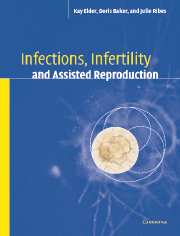3 - Mycology: moulds and yeasts
from Part I - Overview of microbiology
Published online by Cambridge University Press: 29 October 2009
Summary
Intoduction
Medical mycology studies fungi that may produce disease in humans and other animals. Fungi are not related to bacteria: bacteria are prokaryotes, without a membrane-bound nucleus or intracellular organelles; fungi are eukaryotes that have both sexual and asexual reproductive phases, and have membrane-bound organelles including nuclei, mitochondria, golgi apparatus, endoplasmic reticulum, lysosomes, etc. Initially, fungi were thought to be part of the Kingdom of Plantae, albeit lower members of this Kingdom. When the Five Kingdom division of life forms came into general use, however, the fungi were separated into their own Kingdom, separate from the plants, due to their lack of chloroplasts or chlorophyll, the composition of their cell wall and their asexual reproduction by means of spores. Whereas eukaryotes such as plants and algae contain chlorophyll that allows them to generate energy by photosynthesis (autotrophic), fungi lack chlorophyll: they are heterotrophic, and must absorb nutrients from their environment or host. They can be saprophytes, living on dead organic matter (e.g. mushrooms, toadstools, bread mould) or parasites utilizing living tissues (e.g. yeast infections). Fungi are aerobic and non-motile; they have rigid cell walls composed of complex polysaccharides such as chitins or glucans and their plasma membrane contains sterols, principally ergosterol. They grow best at a neutral pH in a moist environment, but can tolerate a range of pH.
- Type
- Chapter
- Information
- Infections, Infertility, and Assisted Reproduction , pp. 90 - 104Publisher: Cambridge University PressPrint publication year: 2004

